Stations 84 | Line length 185.6 km (115.3 mi) | |
 | ||
Ridership 140,000,000 journeys per year Opened 1979
(last extension in 2006) Rolling stock Z 5600, Z 8800, Z 20500, Z 20900 Track gauge 1,435 mm (4 ft 8 ⁄2 in) | ||
The RER C is one of the five lines in the RER rapid transit system serving Paris, France. It is operated by SNCF.
The line runs from the northwestern terminuses Pontoise (C1), Versailles-Château (C5) and Saint-Quentin-en-Yvelines (C7) to the southeastern terminuses Massy-Palaiseau (C2), Dourdan-la-Forêt (C4), Saint-Martin d'Étampes (C6) and Versailles – Chantiers (C8).
The RER C is the second longest line in the network, with over 187 km (116 mi) of route. Each day, over 531 trains run on the RER C alone, and carries over 490,000 passengers daily, which is 100,000 passengers more than the entirety of over 800 TGVs. It is also the most popular RER line for tourists which represents 15% of its passengers, as the line serves many monuments and museums, including the Palace of Versailles. Within the city, the RER functions like the Métro, but is faster as it has fewer stops. This has made it a model for proposals to improve transit within other cities. However some argue that the numerous stops, especially inside Paris, and combined with an old and fragile infrastructure, makes the line very slow and inefficient inside the Parisian section of the RER C.
History
Line C was opened on 26 September 1979 following the construction of a new 1-kilometre (0.62 mi) tunnel connecting the Gare d'Orsay railway terminus (now Musée d'Orsay) with the Invalides terminus of the Rive Gauche line to Versailles, along the banks of the Seine. Services operated between Versailles-Château – Invalides – Quai-d'Orsay, branching to Massy – Palaiseau, and Juvisy – Dourdan / Saint-Martin d'Étampes.
May 1980 : Service extended Saint-Quentin-en-Yvelines – Versailles – Chantiers – Gare des Invalides.
On 25 September 1988 the VMI ("Vallée de Montmorency – Invalides") branch to the north-west opened. This branch mostly used the infrastructure of the "ligne d'Auteuil" (incorporated into the "ligne de petite ceinture" from 1867, closed to passengers from 22 July 1934), and a new 3 kilometres (1.9 mi) tunnel connection between Batignolles and St-Ouen, connecting to the RER C's main trunk at Champ de Mars-Tour Eiffel via a curved bridge (the only one in Paris) over the Seine river. This extended services to Montigny – Beauchamp and Argenteuil.
Porte de Clichy opened on 29 September 1991. Located between Pereire – Levallois and St-Ouen.
In 1992 the line was extended from Juvisy to Versailles.
A further 9 kilometres (5.6 mi) extension from Montigny – Beauchamp to Pontoise was opened on 28 August 2000. On the same day a new station, Bibliothèque François Mitterrand, opened in order to create a new connexion with Métro Line 14. Located between Paris-Austerlitz and Boulevard Masséna (which was closed and replaced by the new station).
Another new station, St-Ouen-l'Aumône-Liesse, opened on 24 March 2002. Located between Pierrelaye and St-Ouen-l'Aumône.
The C3 branch (from Ermont-Eaubonne to Argenteuil) transferred to the Transilien Paris – Saint-Lazare suburban rail network on 27 August 2006.
On 16 December 2006, Boulevard Victor was renamed Boulevard Victor – Pont du Garigliano to highlight the new interchange with tramway line T3. In February 2012, Versailles - Rive Gauche was renamed Versailles-Château, to avoid frequent tourists confusions with other stations in Versailles.
